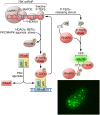Molecular mechanisms of HIV latency
- PMID: 26731470
- PMCID: PMC4731164
- DOI: 10.1172/JCI80565
Molecular mechanisms of HIV latency
Abstract
HIV seeds reservoirs of latent proviruses in the earliest phases of infection. These reservoirs are found in many sites, including circulating cells, the lymphoid system, the brain, and other tissues. The "shock and kill" strategy, where HIV transcription is reactivated so that antiretroviral therapy and the immune system clear the infection, has been proposed as one approach to curing AIDS. In addition to many defective viruses, resting hematopoietic cells harbor transcriptionally latent HIV. Understanding basic mechanisms of HIV gene expression provides a road map for this strategy, allowing for manipulation of critical cellular and viral transcription factors in such a way as to maximize HIV gene expression while avoiding global T cell activation. These transcription factors include NF-κB and the HIV transactivator of transcription (Tat) as well as the cyclin-dependent kinases CDK13 and CDK11 and positive transcription elongation factor b (P-TEFb). Possible therapies involve agents that activate these proteins or release P-TEFb from the inactive 7SK small nuclear ribonucleoprotein (snRNP). These proposed therapies include PKC and MAPK agonists as well as histone deacetylase inhibitors (HDACis) and bromodomain and extraterminal (BET) bromodomain inhibitors (BETis), which act synergistically to reactivate HIV in latently infected cells.
Figures



References
-
- Centers for Disease Control (CDC) Pneumocystis pneumonia — Los Angeles. MMWR Morb Mortal Wkly Rep. 1981;30(21):250–252. - PubMed
Publication types
MeSH terms
Substances
Grants and funding
LinkOut - more resources
Full Text Sources
Other Literature Sources
Medical

